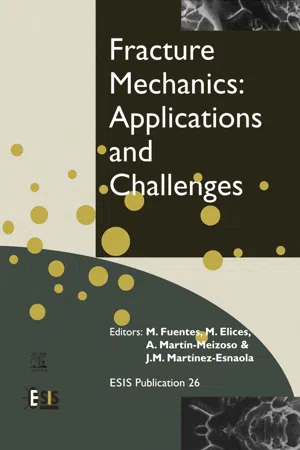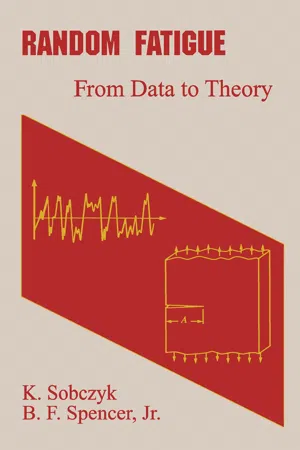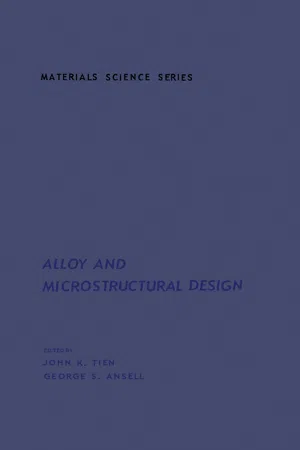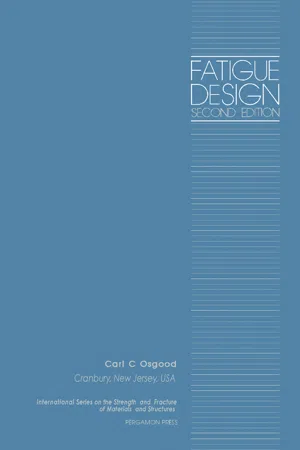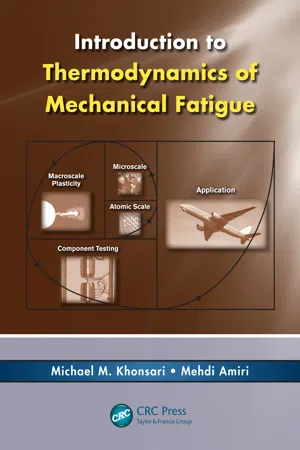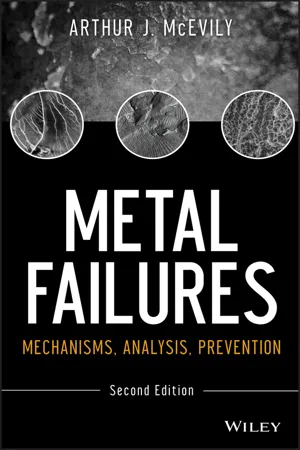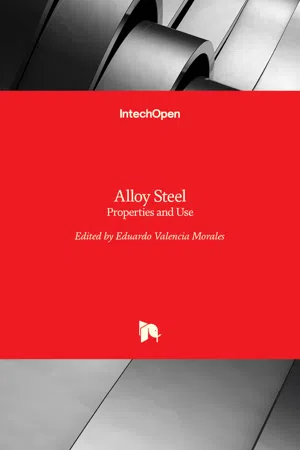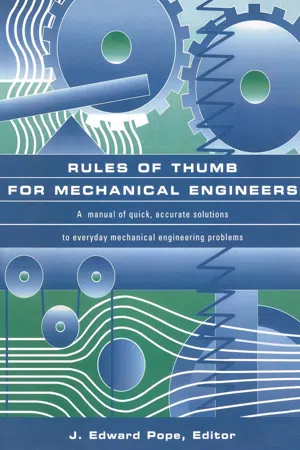Technology & Engineering
Fatigue Material
Fatigue material refers to the degradation of a material's properties under cyclic loading, leading to eventual failure. This phenomenon is a common concern in engineering, particularly in the design and maintenance of structures and components subjected to repeated stress. Understanding fatigue material behavior is crucial for ensuring the reliability and safety of various mechanical systems.
Written by Perlego with AI-assistance
Related key terms
1 of 5
12 Key excerpts on "Fatigue Material"
- M. Fuentes, M. Elices, A. Martín-Meizoso, J.-M. Martínez-Esnaola(Authors)
- 2000(Publication Date)
- Elsevier(Publisher)
13 SOME ASPECTS OF FATIGUE OF ENGINEERING MATERIALS HAEL MUGHRABI Institut ffir Werkstoffwissenschaften, Lehrstuhl I, Universitfit Erlangen-Nfirnberg Martensstr. 5, D-91058 Erlangen, Federal Republic of Germany ABSTRACT Fatigue failures are generally the result of repeated plastic cyclic microstrains leading ultimately to the initiation and propagation of cracks. Fatigue crack initiation (and propagation) can occur in different ways and is frequently preceded by some form of cyclic strain localization. In this presentation, examples will be given of different types of fatigue studies on a number of metallic engineering (and model) materials. The aim will be to highlight different aspects of fatigue behaviour and to illustrate different experimental approaches in the study of fatigue phenomena. Some topics of current interest will be addressed, referring to recent work on the fatigue behaviours of materials of ultrafine grain size, metal-matrix composites, a cast magnesium alloy and, finally, the high-temperature fatigue of monocrystalline nickel-base superalloys. KEYWORDS Fatigue life, ultrafine grain-size materials, metal-matrix composites, cast magnesium alloys, nickel-base superalloys, elastic compliance, damage parameter, fatigue crack initiation, fatigue crack propagation, microstructure. INTRODUCTION Fatigue fracture is one of the most common types of materials failure. It occurs in materials and components subjected to repeated cyclic loads which would normally not cause damage, if applied only once monotonically. It is now well established that fatigue damage originates from (small) repeated cyclic microstrains (in the order of 10.5 to 10-2) which ultimately lead to some form of strain localization, followed by subsequent initiation and propagation of cracks in the case of ductile materials and to almost immediate propagation of cracks in the case of less ductile high-strength materials.- eBook - PDF
Random Fatigue
From Data to Theory
- K. Sobczyk, B. F. Spencer Jr., B. F. Spencer, Jr.(Authors)
- 2012(Publication Date)
- Academic Press(Publisher)
Chapter I Fatigue of Engineering Materials: Empirical Background 1. Introductory Remarks In general, fatigue can be defined as a phenomenon that takes place in com-ponents and structures subjected to time-varying external loadings and that manifests itself in the deterioration of the material's ability to carry the in-tended loading. The fatigue phenomenon today is deemed to originate in the local yield of the material or, in other words, in the sliding of atomic layers. This slid-ing is caused by a combination of dislocations and local stress concentra-tions. It is assumed that each slip, no matter how small, is connected with a small deterioration of the material structure. Under cyclic stress conditions, there is migration of dislocations that result in localized plastic deforma-tions. Microscopic cracks are created that grow and join together to pro-duce major cracks. Nucleation (or crack initiation) and crack growth are commonly regarded as basic causes of fatigue damage accumulation and ultimate fatigue failure. Nucleation and crack growth also constitute two principal phases in the fatigue damage process. (See Fig. 1.1.) The fatigue crack nucleation process is not yet fully understood; how-ever, several models have been proposed to explain the origin of fatigue cracks. (See [23], [36].) In these models, various dislocation mechanisms in the metallic structure play a dominant role. Usually, fatigue cracks occur on the free surface of the body at places of high stress concentration (e.g., inclusions, surface imperfections, grain boundaries, etc.). Depending upon the material properties and the applied loading, the nucleation phase can be 9 10 /. Fatigue of Engineering Materials: Empirical Background complete lifetime nucleation micro-crack growth -10Ä — — , -nucleation period macro-crack growth final failure lmm-crack growth period Figure 1.1. Fatigue life of a structural element. of a different importance in estimating fatigue life. - eBook - PDF
- John Tien(Author)
- 2012(Publication Date)
- Academic Press(Publisher)
Chapter VI FATIGUE RESISTANCE Campbell Laird D E P A R T M E N T O F M E T A L L U R G Y A N D M A T E R I A L S S C I E N C E U N I V E R S I T Y O F P E N N S Y L V A N I A P H I L A D E L P H I A , P E N N S Y L V A N I A I. I N T R O D U C T I O N In designing structures for fatigue applications, mechanical engi-neers have followed a number of different approaches. In the stress-based approach an elastic analysis is carried out on a component of a structure, and the fatigue life for that component is predicted on the basis of the material's S-N curve, the relationship between life and ap-plied stress. This approach, which is one of the oldest, has been suc-cessful largely on the basis of the testing which also accompanies the design. However, it can be extremely expensive because sometimes as many as four iterations of testing and redesign are required before a satisfactory component is achieved (Forrest, 1962). The materials goal associated with this approach is relatively simple; the aim is to raise the fatigue limit or endurance stress to as high a value as possible consis-tent with other service requirements. However, attempts to realize this aim have been difficult and disappointing. The fatigue strength has 175 176 Campbell Laird generally been found to increase with increase in tensile strength, but the rate of increase falls to a very low value at high tensile strengths. A major difficulty with the stress-based approach lies in the defini-tion of fatigue damage. The meaning of this term is vague in relation to stress and has given rise to many problems in cumulative fatigue. Although metallurgists have understood the nature of damage in terms of microcracking phenomena, they have been unable to make quantita-tive predictions that mechanical engineers feel comfortable in using. - H. Liebowitz(Author)
- 2014(Publication Date)
- Academic Press(Publisher)
The fatigue limit of a high-strength material is, at best, at about 50 % of its engineering yield limit, and stresses causing fatigue lives of practical importance are still in the nominally elastic range. For the purpose of the present discussion, high-strength metals may be distinguished 436 MARIA RONAY from soft metals in terms of their fatigue behavior as materials with a fatigue limit and with fatigue lives of practical importance strained within the range of microplasticity. Such materials soften rather than harden during cyclic loading, and their fatigue failure starts at stress concentra-tions inherent in the material or in the engineering structure rather than at concentrations due to a characteristic surface topography produced by the cyclic loading itself. Very little work has been done concerning the basic mechanism of fatigue in high-strength materials. Part of the reason for this may be the fact that it is extremely difficult to observe microstructural changes due to the fatigue process in such materials. Optical and electron microscopy, which proved to be very useful tools in investigating fatigue in pure metals, are often useless, either because the complexity of the structure and the high density of precipitate particles obscures any changes resulting from fatigue, or because there is nothing to see. The difficulty in treating fatigue, both experimentally and theoretically, lies in the highly localized nature of the phenomenon. While this diffi-culty arises in every material, the less ductile the material under the given conditions, the sharper is this localization. Thus, significant details of the fatigue mechanism may remain below the resolution of the electron microscope. The author does not attempt to review in the present paper the large amount of existing fatigue data for high-strength materials, but, rather, tries to present initial attempts toward an understanding of the fatigue phenomenon in high-strength materials.- Christian Lalanne(Author)
- 2014(Publication Date)
- Wiley-ISTE(Publisher)
Other phenomena such as shocks measured on an aircraft’s landing gear, the starting or stopping of rotating machines, missile and launcher staging, etc. are all transitory, either centered on a given frequency or not.All these loads lead to effects of fatigue that are much harder to evaluate experimentally, especially in a projected manner. In the following sections, we will show how we can estimate them.1.3. Damage arising from fatigue
We define the modification of the characteristics of a material, primarily due to the formation of cracks and resulting from the repeated application of stress cycles, as fatigue damage. This change can lead to a failure.We will not consider here the mechanisms of nucleation and growth of the cracks. We will simply state that fatigue starts with a plastic deformation, initially highly localized around certain macroscopic defects (inclusions, cracks of manufacture, etc.), under total stresses which can be lower than the yield stress of the material. The effect is extremely weak and negligible for only one cycle. If the stress is repeated, each cycle creates a new localized plasticity. After a number of variable cycles, depending on the level of the applied stress, ultra-microscopic cracks can be formed in the newly plastic area. The plastic deformation then extends from the ends of the cracks which increase until becoming visible with the naked eye, and lead to failure of the part. Fatigue damage is a cumulative phenomenon.If the stress–strain cycle is plotted, the hysteresis loop obtained is an open curve whose form evolves depending on the number of applied cycles [FEO 69]. Each cycle of stress produces certain damage and the succession of the cycles results in a cumulative effect.The damage is accompanied by modifications of the mechanical properties and, in particular, of a reduction of the static ultimate tensile strength Rm and of the fatigue limit strength.This is generally local to the place of a geometrical discontinuity or a metallurgical defect. The fatigue damage is also related to metallurgical and mechanical phenomena, with the appearance and growth of cracks depending on the microstructural evolution and mechanical parameters (possibly with the effects of the environment).- eBook - PDF
Fatigue Design
International Series on the Strength and Fracture of Materials and Structures
- Carl C. Osgood, D. M. R. Taplin(Authors)
- 2013(Publication Date)
- Pergamon(Publisher)
Fatigue tests are made for a wide variety of reasons, among them: 1. To determine a material property such as the endurance limit stress or the life at a given stress level; both of which are, of course, affected by the many variables of material condition, mode and sequence of loading, etc. 2. To investigate the behavior of a part or an assembly in terms of an allowable fatigue stress at a required life, or the inverse; to check locations of maximum stress and the values of the stress concentration factors; and to see the actual effects of environmental factors as temperature and corrosion. 3. To compare designs on the basis of stress or life. 4. To determine the residual strength of a damaged article, in which the term damaged includes the partial consumption of the conventional fatigue life. The evolution of fatigue testing has been in the direction of increasing sophisti-cation, urged on by the ever-increasing need to express more properly and completely the material parameters and the service conditions. From the original, simple ro-tating beams, the samples have progressed to bi- and tri-axially stressed geometries, with and without preloads and gradients; on to very large (i.e., 8 ft x 20 ft) panels of an actual construction with carefully introduced loads, and finally to full-size aircraft and autos of a proposed construction. Of equal concern is the proper expression of the loads, periodic and random, programmed or sequenced, and the test equipment for producing them. In this regard, the leading efforts have been made by the aerospace and automotive industries in cooperation with govern-mental laboratories, especially ASIP, the Aircraft Structural Integrity Program. ASIP is generally described in MIL-STD-1530A and 83444 which make reference to the detailed specifications for damage tolerance and durability (fatigue). - Michael M. Khonsari, Mehdi Amiri(Authors)
- 2012(Publication Date)
- CRC Press(Publisher)
49 4 Fatigue Mechanisms: An Overview In this chapter, we discuss the fundamentals of fatigue. Particularly, multiaxial and variable amplitude loading fatigue are presented and discussed. Also presented is the relationship between fatigue, energy dissipation, and temperature evolution. 4.1 MULTISCALE CHARACTERISTICS OF FATIGUE A review of the massive number of publications in the fatigue area reveals that challenges in modeling its mechanisms have been only partially successful: no models can claim to be complete. The difficulties in addressing the degradation in a fatigue system arise from the inherent complexity of the material behavior in response to the load at multiple length scales (Zhang and Wang 2008). Incredibly small devices are now being produced with the representative length scale on the order of micro- and nanometer in which the occurrence of any nanoscale defect during the production could result in sudden failure. Therefore, the applicability of the conventional theoretical and experimental approaches developed for bulk material should be reexamined when dealing with micro- and nanoscale fatigue appli-cations. This calls for the need to address the hierarchical multiscale modeling (Figure 4.1) to complement the traditional approaches. Defects develop initially at the atomic scale due to cyclic slip and grow to a form of microscopic fatigue damage commonly known as micro-plasticity that accumulates irreversibility to form micro- to macrocracks (Mughrabi 2009). Further application of the cyclic load leads to accumulation and growth of a microcrack(s) into a macrocrack and finally, at the level of macroscale, the crack propagates due to the irreversible plastic deformation at the crack tip until failure occurs. The next hierarchical level involves extensive component testing and analysis before application in the field can be realized.- eBook - PDF
Metal Failures
Mechanisms, Analysis, Prevention
- Arthur J. McEvily, Jirapong Kasivitamnuay(Authors)
- 2013(Publication Date)
- Wiley-Interscience(Publisher)
10 Fatigue I. INTRODUCTION Fatigue is a leading cause of failure in mechanical components that are subjected to cyclic loading. This chapter deals with the historical background of fatigue and mechanisms of crack initiation and growth of fatigue cracks, together with a consideration of design procedures and a discussion of some case studies. II. BACKGROUND A fatigue failure is the result of the repeated application of stress below the tensile strength of the material but above a stress amplitude that corresponds to the fatigue strength of the material. Fatigue failure consists of three processes: initiation of one or more cracks, the growth of a dominant crack, and final separation (fracture). Research has shown that plastic deformation is necessary for both the initiation and propagation of fatigue cracks. A perfectly brittle material such as diamond cannot fail in fatigue. Another requirement is that the cross-slip of screw dislocations is possible. Cross-slip is that process wherein a screw dislocation is able to move from one slip plane to an intersecting slip plane. In those materials where cross-slip is not an easy process, such as sodium chloride (NaCl), magnesium oxide (MgO), and lithium fluoride (LiF), fatigue failure does not occur. It would appear therefore that cross-slip should be involved in any mechanism for fatigue crack initiation. In the first half of the nineteenth century, a number of train wrecks occurred in England and Germany as the result of fatigue failure of railroad car axles. The cause 237 238 FATIGUE of the first failures must have been a complete mystery, for the existence of fatigue was not known at the time, but as more accidents occurred, engineers realized that they had a new phenomenon on their hands that had to be dealt with, and as result a number of investigations were initiated. The term fatigue was first used in 1839 by Poncelet in describing failure due to the repeated action of tension and compression. - eBook - PDF
Alloy Steel
Properties and Use
- Eduardo Valencia Morales(Author)
- 2011(Publication Date)
- IntechOpen(Publisher)
When the stress level is high enough for plastic deformation to occur, the fatigue is known as low cycle type. Number of cycles needed for fracture in such a case is low. The account of this regime in terms of stress is less useful and the strain in the material offers an adequate description. Low cycle fatigue is also termed as strain based fatigue. Direction of load too influences fatigue. Multi-axial loads result in different fatigue characteristics than uni-axial loads. Fatigue under pure mechanical loads is rate independent. B. Environment based : Fatigue characteristics are affected by operating temperature and aqueous and corrosive environments. Fatigue under high temperature is rate dependant. 1.2.4 Factors influencing fatigue life Fig. 2. Types of fatigue cycles A. Metal microstructure : Metal with large grains have low yield strength and reduced fatigue limit and vice-versa. However, at higher temperatures, the coarse grained metal is seen to show better fatigue properties. Barriers to crack growth in the form of precipitates, impurities, grain boundaries, etc. improve fatigue properties. Phase transformations occurring during cyclic loading can also influence the fatigue life. Metal Fatigue and Basic Theoretical Models: A Review 207 B. Manufacturing process : Fatigue properties are better in the direction of forging, extrusion and rolling and are lower in the transverse direction. Some specific processes like shot peening, cold rolling etc. and other hardening/heat treatment methods that induce compressive residual stresses reduce the chances of crack initiation and enhance the fatigue properties. Tensile residual stresses on the other hand promote crack initiation. Other manufacturing processes like forming, drawing, forging, extrusion, rolling, machining, punching etc., that produce rough surfaces, decrease fatigue life. A rough surface possesses more crack initiation sites due to unevenness and asperities. - H.P. Rossmanith(Author)
- 1993(Publication Date)
- CRC Press(Publisher)
PART THREE FATIGUE 19 PROPERTIES OF CONCRETE RELATED TO FATIGUE DAMAGE G. PETKOVIC SINTEF Structural Engineering -FCB, Trondheim, Norway R. LENSCHOW Division for Structural Engineering, Norwegian Institute of Technology, Trondheim, Norway Abstract This paper gives an overview of the changes of strength and strain related properties of concrete under the influence of repeated loading. Changes in strain, strain rate, modulus of elasticity, and Poisson's ratio have been followed during cyclic loading, and in static tests after cyclic preloading. Loading situations resulting and not resulting in fatigue failure have been compared, so as to relate the criteria for an endurance limit to material characteristics. Special attention is paid to properties in the direction perpendicular to the application of loading. The relationship between transverse strain rate and the fatigue life was used for obtaining a formulation for the average damage rate as a function of the stress level. This article summarizes the contents of a thesis, and due to the lack of space includes only its most important parts. For more detailed information please see the full thesis (Petkovic, 1991). Keywords: Fatigue, Compression, Strain, Damage, High strength concrete, Lightweight aggregate concrete. 1 Introduction The expressions used for fatigue design are based on experimentally obtained S-N diagrams, which are in the usual form relatively well known and are similar in the existing codes of practice. The fact that this usual form is not satisfactory, and that not much of today's research in fatigue has yet found its way to design codes makes fatigue of concrete be still looked upon as a new research field. No experimental procedures are standardized, which makes results obtained in different laboratories difficult to compare. Due to the costs connected to such experiments one lacks data at the load levels which are most interesting for practice and has abundant data at less interesting load levels.- eBook - PDF
- J. Edward Pope(Author)
- 1996(Publication Date)
- Gulf Professional Publishing(Publisher)
H., and Manson, S. S., Fatigue Behavior of Materials Under Strain Cycling in Low and Intermediate Life Range, NASA TN D- 1574, April 1963. 4. Miner, M. A., Cumulative Damage in Fatigue, Trans. ASME, J. Appl. Mech., Volume 67, Sept. 1945, p. A159. 5. Marin, J., Interpretation of Fatigue Strengths for Com- bined Stresses, presented at The American Society of Mechanical Engineers, New York, Nov. 28-30, 1956. 6. Muralidharan, U. and Manson, S. S., A Modified Universal Slopes Equation for the Estimation of Fatigue Characteristics of Metals, Journal of Engineering Materials and Technology, Volume 110, Jan. 1988, pp. 55-58. 7. Irwin, G. R., Analysis of Stresses and Strains Near the End of a Crack Transversing a Plate, Trans ASME, J. Appl. Mech., Volume 24, 1957, p. 361. 8. Paris, P. C. and Erdogan, F., A Critical Analysis of Crack Propagation Law, Trans. ASME, J. Basic Engr., Volume 85, No. 4, 1963, p. 528. 9. Barsom, J. M., Fatigue-Crack Propagation in Steels of Various Yield Strengths, Trans. ASME, J. Eng. Ind., Ser. B, No. 4, Nov. 1971, p. 1190. 10. Troha, W. A., Nicholas, T., Grandt, A. E, Observations of Three-Dimensional Surface Flaw Geometries Dur- ing Fatigue Crack Growth in PMMA, Surface-Crack Growth: Models, Experiments, and Structures, ASTM STP 1060, 1990, pp. 260-286. 11. McComb, T. H., Pope, J. E., and Grandt, A. E, Growth and Coalesence of Multiple Fatigue Cracks in Poly- carbonate Test Specimens, Engineering Fracture Me- chanics, Volume 24, No. 4, 1986, pp. 601-608. 12. Stinchcomb, W. W., and Ashbaugh, N. E., Composite Materials: Fatigue and Fracture, Fourth Volume, ASTM STP 1156, 1993. 13. Deutschman, A. D., Michels, W. J., and Wilson, C. E., Machine Design Theory and Practice. New Jersey Prentice Hall, 1975, p. 893. Fatigue 351 14. Fuchs, H. O. and Stephens, R. I., Metal Fatigue in En- gineering. New York: John Wiley & Sons, Inc., 1980. 15. Mann, J. Y., Fatigue of Materials. Victoria, Australia: Melbourne University Press, 1967. - Wole Soboyejo(Author)
- 2002(Publication Date)
- CRC Press(Publisher)
T h is w a s d em o n stra ted fo r cyclic c o m p r essio n lo a d in g o f n o tc h e d p la tes by E w art a n d Su resh (1987). Fatigue of Materials 481 U n lik e du ctile solid s, w h ere m a cro sco p ic fatigu e can arise from cyclic slip, the drivin g forces for the crack gro w th at r o o m tem p eratu re m a y in v o lv e the d eg ra d a tio n o f brid gin g z o n es b eh in d the crack tip (F ig. 14.24), m icrocrack in g, m arten sitic tra n sfo rm a tio n s, and in terfacial slid in g (Su res, 1999). H o w ev er, at elevated tem p eratu re, so m e sem ib rittle so lid s can exh ib it characteristics o f fatigu e d am age th at are ap p aren tly sim ilar to th o se fo u n d in d u ctile m etals at elevan ted tem p erature (A rg o n an d G o o d r ic h , 1969). It is im p o rta n t to n o te here th at several ceram ics exh ib it stab le crack g row th p h en o m en a u n der static or q u asistatic lo a d s (E van s an d F u ller, 1974; W id erh orn et al., 1980). U n d er su ch c o n d itio n s, it is c o m m o n to express the tim e rate o f crack grow th , da/dt, as a fu n ctio n o f the lin ear elastic stress in ten sity factor, K : w h ere A an d p are m aterial c o n sta n ts th at are o b ta in ed from crack grow th exp erim en ts u n d er static lo a d in g . It is a lso im p o rta n t to n o te here th a t stab le crack g ro w th in ceram ics is o ften a sso cia ted w ith to u g h en in g m ech a n ism s su ch as crack brid gin g or tra n sfo rm a tio n to u g h n ess by stress-in d u ced m ar-(14.8) Extrinsic Toughening Intrinsic Toughening behind crack tip ahead of crack tip F igure 14.24 Schematic illustration of intrinsic and extrinsic fatigue damage mechanics. (From Ritchie et al., 2000— reprinted with permission from Elsevier Science.) 482 Chapter 14 ten sitic p h a se tra n sfo rm a tio n s.
Index pages curate the most relevant extracts from our library of academic textbooks. They’ve been created using an in-house natural language model (NLM), each adding context and meaning to key research topics.
